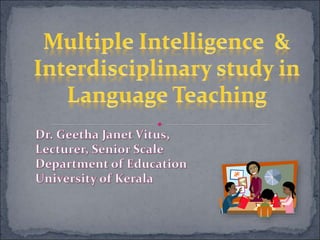
Multiple Intelligences Framework for Language Learning
- 6. : having a well-coordinated body, something found in athletes and crafts persons. the ability to be able to work well with people, which is strong in salespeople, politicians, and teachers. the ability to understand oneself and apply one’s talent successfully, which leads to happy and well-adjusted people in all areas of life. the ability to understand and organize the patterns of nature. the proclivity to pose (and ponder) questions about life, death, and ultimate realities and is the sensitivity and capacity to tackle deep questions about human existence.
- 7. Awaken the Intelligence. Through multi-sensory experiences –touching, smelling, tasting, seeing, and so on – learners can be sensitized to the many-faceted properties of objects and events in the world that surrounds them. Amplify the Intelligence. Students strengthen and improve the intelligence by volunteering objects and events of their own choosing and defining with others the properties and contexts of experience of these objects and events.
- 8. Teach with/for the Intelligence. At this stage the intelligence is linked to the focus of the class, that is, to some aspect of language learning. This is done via worksheets and small-group projects and discussion. Transfer of the Intelligence. Students reflect on the learning experiences of the previous three stages and relate these to issues and challenges in the out-of-class world.
- 9. These are based on one or more of the intelligences and are designed to stimulate particular intelligences. These are based on curriculum content areas but are categorized according to the particular intelligences they make use of.
- 11. If you want an athlete or a musician (or a student having some of the these talents) to be an involved and successful language learner, structure the learning material for each individual (or similar group of individuals) around these strengths. Providing a teacher-directed rich mix of learning activities variously calling upon the eight different intelligences makes for an interesting, lively, and effective classroom for all students.
- 15. Teachers become curriculum developers, lesson designers and analysts, activity finders or inventors, and, most critically orchestrators of a rich array of multisensory activities within the realistic constraints of time, space, and resources of the classroom. Teachers are encouraged not to think of themselves merely as language teachers. They have a role that is not only to improve the second language abilities of their students but to become major “contributors to the overall development of students’ intelligences” (Christison 1999).
- 16. Linguistic Intelligence lectures - student speeches small- and large-group discussions - books storytelling-debates worksheets - journal keeping word games - memorizing listening to cassettes or talking books- using word processors publishing (creating class newspapers or collections of writing)
- 23. Stage 1: Awaken the Intelligence. The teacher brings many different objects to class. Students experience feeling things that are soft, rough, cold, smooth, and so on. They might taste things that are sweet, salty, sour, spicy, and so on. Experiences like this help activate and make learners aware of the sensory bases of experience. Stage 2. Amplify the Intelligence. Students are asked to bring objects to class or to use something in their possession. Teams of students describe each object attending to the five physical senses. They complete a worksheet including the information they have observed and discussed.
- 24. Teach with/for the Intelligence. At this stage, the teacher structures larger sections of lesson(s) so as to reinforce and emphasize sensory experiences and the language that accompanies these experiences. Students work in groups, perhaps completing a worksheet. Transfer of the Intelligence. This stage is concerned with application of the intelligence to daily living. Students are asked to reflect on both the content of the lesson and its operational procedures (working in groups, completing tables, etc.).